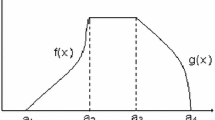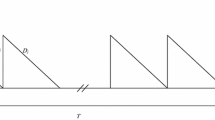Abstract
In this paper, a multi-item multiperiod inventory control problem with all-unit and/or incremental quantity discount policies under limited storage capacity is presented. The independent random demand rates of the items in the periods are known and the items are supplied in distinct batch sizes. The cost consists of ordering, holding, and purchasing. The objective is to find the optimal order quantities of all items in different periods such that the total inventory cost is minimized and the constraint is satisfied. A mixed binary integer programming model is first developed to model the problem. Then, a parameter-tuned genetic algorithm (GA) is employed to solve it. Since there is no benchmark available in the literature, a memetic algorithm (MA) is utilized as well to validate and verify the results obtained. The model implementation is next presented using some numerical examples and finally the performances of the proposed GA and MA are compared using two statistical tests and a simple additive weighting method. The results show that GA has better performance than MA in terms of average objective function value and average run time using the two comparison procedures.
Similar content being viewed by others
References
Roach B (2005) Origin of the economic order quantity formula; transcription or transformation? Manag Decis 43:1262–1268
Lee AHI, Kang H-Y (2008) A mixed 0-1 integer programming for inventory model: a case study of TFT-LCD manufacturing company in Taiwan. Kybernetes 37:66–82
Das K, Roy TK, Maiti M (2000) Multi-item inventory model with quantity-dependent inventory costs and demand-dependent unit cost under imprecise objective and restrictions: a geometric programming approach. Prod Plan Control 11:781–788
Silver EA, Moon I (2001) Multi-item economic order quantity model with an initial stock of convertible units. Eng Econ 46:129–138
Panda S, Banerjee K, Basu M (2005) Determination of EOQ of multi-item inventory problems through nonlinear goal programming with penalty function. Asia Pac J Oper Res 22:539–553
Kim JU, Kim YD (2000) A Lagrangian relaxation approach to multi-period inventory/distribution planning. J Oper Res Soc 51:264–370
Luciano E, Peccati L, Cifarelli DM (2002) VaR as a risk measure for multiperiod static inventory models. Int J Prod Econ 81:375–384
Matsuyama K (2006) The multi-period newsboy problem. Eur J Oper Res 171:170–88
Maiti AK, Maiti M (2008) Discounted multi-item inventory model via genetic algorithm with roulette wheel selection, arithmetic crossover and uniform mutation in constraints bounded domains. Int J Comput Math 85:1341–1353
Sana SS, Chaudhuri KS (2008) A deterministic EOQ model with delays in payments and price-discount offers. Eur J Oper Res 184:509–533
Dellaert N, Jeunet J, Jonard N (2000) A genetic algorithm to solve the general multi-level lot-sizing problem with time-varying costs. Int J Prod Econ 68:241–257
Rezaei J, Davoodi M (2008) A deterministic, multi-item inventory model with supplier selection and imperfect quality. Appl Math Model 32:2106–2116
Guner Goren H, Tunali S, Jans R (2010) A review of applications of genetic algorithms in lot sizing. J Intell Manuf 21:575–590
Rezaei J, Davoodi M (2011) Multi-objective models for lot-sizing with supplier selection. Int J Prod Econ 130:77–86
Schemeleva K, Delorme X, Dolgui A, Grimaud F (2012) Multi-product sequencing and lot-sizing under uncertainties: a memetic algorithm. Eng Appl Artif Intel 25:1598–1610
Hillier FS, Lieberman GJ (2001) Introduction to operations research. McGraw-Hill, New York
Fugenschuh A, Martin A (2005) Computational integer programming and cutting planes. Discrete Opt 25:69–121
Ziaee M, Sadjadi SJ (2007) Mixed binary integer programming formulations for the flow shop scheduling problems. A case study: ISD projects scheduling. Appl Math Comput 185:218–228
Pan JC-H, Chen J-S (2005) Mixed binary integer programming formulations for the reentrant job shop scheduling problem. Comput Oper Res 32:1197–1212
Kozanidis G, Melachrinoudis E (2004) A branch & bound algorithm for the 0-1 mixed integer knapsack problem with linear multiple choice constraints. Comput Oper Res 31:695–711
Michalewicz Z, Janikow CZ (1991) Genetic algorithms for numerical optimization. Stat Comput 1:75–91
Guvenir HA (1995) In: Pearson DW, Steele NC, Albrecht RF (eds) A genetic algorithm for multicriteria inventory classification in artificial neural nets and genetic algorithms. Proceedings of the International Conference, Ales, France. Springer, Wien
Davis L (ed) (1991) Handbook of genetic algorithms. Reinhold, NewYork
Pal SK, De S, Ghosh A (1997) Designing Hopfield type networks using genetic algorithms and its caparisons with simulated annealing. Int J Patterns Recog Artif Intell 11:447–461
Mondal S, Maiti M (2002) Multi-item fuzzy EOQ models using genetic algorithm. Comput Ind Eng 44:105–117
Maiti MK, Maiti M (2005) Production policy for damageable items with variable cost function in an imperfect production process via genetic algorithm. Math Comput Model 42:977–990
Maiti MK, Maiti M (2006) Fuzzy inventory model with two-warehouse under possibility constraints. Fuzzy Set Syst 157:52–73
Maiti MK, Maiti M (2013) Two-storage inventory model with lot size dependent fuzzy lead-time under possibility constraints via genetic algorithm. Eur J Oper Res 207(179):352–371
Pasandideh SHR, Niaki STA, Mirhosseyni SS (2010) A parameter-tuned genetic algorithm to solve multi-product economic production quantity model with defective items, rework, and constrained space. Int J Adv Manuf Technol 49:827–837
Pasandideh SHR, Niaki STA, Aryan Yeganeh J (2010) A parameter-tuned genetic algorithm for multi-product economic production quantity model with space constraint, discrete delivery orders and shortages. Adv Eng Softw 41:306–314
Pasandideh SHR, Niaki STA, Roozbeh-Nia A (2011) A genetic algorithm for vendor managed inventory control system of multi-product multi-constraint economic order quantity model. Expert Syst Appl 38:2708–2716
Pasandideh SHR, Niaki STA (2008) A genetic algorithm approach to optimize a multi-products EPQ model with discrete delivery orders and constrained space. Appl Math Comput 195:506–514
Taleizadeh AA, Niaki STA, Aryanezhad MB, Fallah Tafti A (2010) A genetic algorithm to optimize multi-product multi-constraint inventory control system with stochastic replenishment and discount. Int J Adv Manuf Technol 51:311–323
Taleizadeh AA, Niaki STA, Hoseini V (2009) Optimizing the multi-product, multi-constraint, bi-objective newsboy problem with discount by a hybrid method of goal programming and genetic algorithm. Eng Optim 41:437–457
Taleizadeh AA, Niaki STA, Aryanezhad MB (2009) A hybrid method of Pareto, TOPSIS, and genetic algorithm to optimize multi-product, multi-constraint inventory systems with random fuzzy replenishments. Math Comput Model 49:1044–1057
Taleizadeh AA, Niaki STA, Aryanezhad MB (2009) Multi-product multi-constraint inventory control systems with stochastic replenishment and discount under fuzzy purchasing price and holding costs. Am J Appl Sci 6:1–12
Taleizadeh AA, Niaki STA, Hosseini SV (2008) The multi-product multi-constraint newsboy problem with incremental discount and batch order. Asian J Appl Sci 1:110–122
Taleizadeh AA, Aryanezhad MB, Niaki STA (2008) Optimizing multi-product multi-constraint inventory control systems with stochastic replenishments. J Appl Sci 8:1228–1234
Moscato P (1989) On evolution, search, optimization, genetic algorithms and martial arts: towards memetic algorithms. Technical Report, Caltech Concurrent Computation Program, Report 826. California Institute of Technology, Pasadena
Reeves C (1996) Hybrid genetic algorithms for bin-packing and related problems. Ann Oper Res 63:371–396
Burke E, Newall J, Weare R (1996) A memetic algorithm for university exam timetabling. In: Burke E, Ross P (eds) The practice and theory of automated timetabling. Lecture notes in Computer Science 1153. Springer, New York, pp 241–250
Fleurent C, Ferland J (1997) Genetic and hybrid algorithms for graph coloring. Ann Oper Res 63:437–461
He L, Mort N (2000) Hybrid genetic algorithms for telecommunications network back-up routing. BT Technol J 18:42–50
Cheng R, Gen M (1997) Parallel machine scheduling problems using memetic algorithms. Comput Ind Eng 33:761–764
Hart, WE (1994) Adaptive global optimization with local search. Ph.D. Thesis, University of California, San Diego
Morris GM, Goodsell DS, Halliday RS, Huey R, Hart WE, Belew RK, Olson AJ (1998) Automated docking using a Lamarkian genetic algorithm and an empirical binding free energy function. J Comp Chem 14:1639–1662
Niesse J, Mayne H (1996) Global geometry optimization of atomic clusters using a modified genetic algorithm in space-fixed coordinates. J Chem Phys 105:4700–4706
Wang H, Wang D, Yang S (2008) A memetic algorithm with adaptive hill climbing strategy for dynamic optimization problems. Soft Comput 13:763–780
Caponio A, Cascella G, Neri F, Salvatore N, Sumner M (2007) A fast adaptive memetic algorithm for on-line and off-line control design of PMSM drives. IEEE Trans Syst Man Cybern B 37:28–41
Ishibuchi H, Kaige S (2004) Implementation of simple multiobjective memetic algorithms and its application to knapsack problems. Int J Hybrid Intell Syst 1:22–35
Jaszkiewicz A (2002) Genetic local search for multi-objective combinatorial optimization. Eur J Oper Res 137:50–71
Liu D, Tan KC, Goh CK, Ho WK (2007) A multiobjective memetic algorithm based on particle swarm optimization. IEEE Trans Syst Man Cybern B 37:42–50
Moscato P (1999) Memetic algorithms: a short introduction. In: Corne D, Glover F, Dorigo M (eds) New ideas in optimization. McGraw-Hill, Maidenhead
Franca PM, Mendes AS, Moscato P (2001) A memetic algorithm for the total tardiness single machine scheduling problem. Eur J Oper Res 132:224–242
Mendes AS, Muller FM, Franca PM, Moscato P (2002) Comparing meta-heuristic approaches for parallel machine scheduling problems. Prod Plan Control 13:143–154
Moscato P, Cotta C (2003) A gentle introduction to memetic algorithms. In: Glover F, Kochenberger G (eds) Handbook of metaheuristics. Kluwer, Boston
Ng EYK, Ng EWK (2006) Parametric study of the biopotential equation for breast tumors identification using ANOVA and Taguchi method. Med Biol Eng Comput 44:131–139
Phadke MS (1989) Quality engineering using robust design. Prentice-Hall, Upper Saddle River
Ross RJ (1989) Taguchi techniques for quality engineering. McGraw-Hill, New York
Holland JH (1975) Adaptive in natural and artificial systems. University of Michigan Press, Ann Arbor
Goldberg D.E. (1989) Genetic algorithms in search, optimization and machine learning. 1st ed. Boston: Addison-Wesley
Kirkpatrick S, Gelatt CD, Vecchi MP (1983) Optimization by simulated annealing. Science 220:671–680
Author information
Authors and Affiliations
Corresponding author
Rights and permissions
About this article
Cite this article
Pasandideh, S.H.R., Niaki, S.T.A. & Mousavi, S.M. Two metaheuristics to solve a multi-item multiperiod inventory control problem under storage constraint and discounts. Int J Adv Manuf Technol 69, 1671–1684 (2013). https://doi.org/10.1007/s00170-013-5130-7
Received:
Accepted:
Published:
Issue Date:
DOI: https://doi.org/10.1007/s00170-013-5130-7




